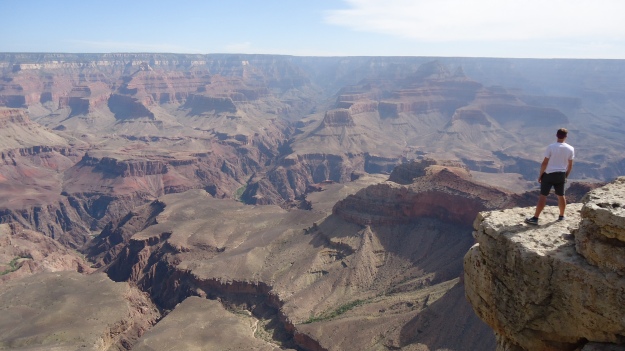When it comes to meteorology, not many people understand the complex diurnal evolution of the Boundary Layer (BL). Every day, the sun transforms the characteristics of the boundary layer into a well-mixed convective mass conserving machine. This process, along with others which I will address throughout this paper, make the study of the boundary layer very important. The study of the boundary layer is also important because we spend nearly all of our lives living in it. Forecasts for temperature, dew point, surface winds are all really BL forecasts. We also look at the BL in studying the production or dissipation of turbulent motion through a variety of terms that will be discussed. The study of turbulence presents many issues. How do we model turbulence? How do we differentiate turbulence from other large scale dynamical phenomena? How do we forecast turbulence in the real atmosphere? These are all questions that need to be considered. This turbulent motion or the deviations of the instantaneous mean wind flow (Panofsky, 1959) also causes many issues for aviation operations at airports and the surrounding terminal aerodrome where planes are coming up and down through the boundary layer. Everyday worldwide. According to the FAA’s website, 24 people were injured in 2013 due to turbulence experienced while in flight. In the last 10 years, 369 people have been injured in flight due to turbulence. Notice that no one has died due to turbulence! The encounter of turbulence can come with nearly zero forewarning which is how most of these injuries occur and is also why this is still such an active area of interest. It also however is extremely common, should it be that big of a deal?
In this post, I plan to review the production and dissipation of turbulence in the boundary layer with a focus on its potential effects on the aviation industry. I plan to explain what is objective in a subjective manner as to appeal to a larger, more lay audience. I will start with an introduction to the exciting subject of Boundary Layer Meteorology. From there I will discuss the characteristics of turbulence in the boundary layer as well as its production and dissipation. In the last section, I will discuss the implications of this turbulence on aviation operations in the boundary layer.
Hello Boundary Layer
In studying Boundary Layer during one of the busiest semesters of my college career, it has been a difficult subject to grasp. Take everything you learn in dynamics regarding the governing equations of the atmosphere and apply it to a much smaller time and grid scale. While you are at it, it is for all practical purposes mathematically impossible to model turbulence by following parcels like we do in Synoptic Meteorology. Therefore we apply statistics and utilize ensemble means to reduce the variance in understanding how turbulence progresses through the BL. Don’t let this scare you though! The idea of understanding turbulence and Boundary Layer processes is something that we still have yet to accomplish in classical physics. I plan to explain these things in a simple manner.
Before I go too deep however, let me make some brief introductions to the subject. Boundary Layer Meteorology is the study of how Earth’s surface effects the bottom 3km of the atmosphere over a short time period of roughly an hour or less. There are many meteorological processes which occur in the BL. Most notably including the fair weather cumulus clouds and stratocumulus clouds which includes fog. Ultimately however, the entire troposphere is influenced by changes in the characteristics of Earth’s surface (Stull, 1988). Thunderstorm formation, although not a BL process by itself, is heavily influenced by the BL through surface convection, cold pool interactions, outflow boundaries and various other processes which occur in the BL (Stull, 1988). How do conditions in the BL change? This is a broad question that someone just learning the subject might ask. It certainly isn’t an easy question to answer. Simply put though, change occurs in the BL due to the wind and changes in incident solar radiation. Now wind can be broken up into three categories: mean wind, turbulence and waves (Stull, 1988). I assume you understand what the mean wind is, it is self-defined. What I want to focus on is the occurrence of turbulence and how it is one of the most important transport processes in the BL. As defined above in my introduction, turbulence is the deviations of the instantaneous mean wind flow or the gustiness imposed on the mean wind flow (Stull, 1988). Differences in solar heating lead to the production or dissipation of turbulence and also lead to the different types of layers seen within the BL which do include but are not limited to the mixed layer, the residual layer, the stable boundary layer, the surface layer and a few others that I won’t mention for purposes of keeping this post short (Figure 1). These different layers are products of different thermal and flow properties. The mixed layer occurs in the afternoon when radiational convergence at the surface causes convection and therefore the vertical expansion of the BL as air warms, expands and then rises. The residual layer forms at sunset when surface heating is lost, turbulence begins to dissipate at the surface instead of being produced. However, the layer maintains characteristics similar to that of the mixed layer, but is now just separated from the surface. It is this layer that can instigate early morning thunderstorms. Moving into night time is when the stable BL forms as the tendency of air in contact with the surface will be to cool and become stable. The surface layer refers to the layer nearest to the surface. So this is anywhere from centimeters above the surface to a few meters. Some scientists define it as the bottom 10% of the BL. Turbulence is contained in all of these layers and in the next section I will go into more depth as to what the characteristics of turbulence are.
Turbulence
In doing some research for this paper, I have read a few cases of injuries experienced on planes where turbulence was the cause of injury. The one that flew out to me the most was a case of a flight from Rio de Janeiro to Houston which was forced to make an emergency landing in Miami due to 4 seriously injured passengers in August of 2011. 26 people were injured on this flight due to turbulence. That was not what stood out to me about this article though. What stood out to me was how the article highlighted that different meteorologists were saying different things regarding the presence of turbulence during the flight. Directly from the article, “Meteorologists differed on weather conditions at the time the Houston-bound plane encountered the turbulence just northwest of Puerto Rico.” I got the feeling from this article that people don’t recognize the physical complexity of turbulence and trying to predict its occurrence. Meteorologists are justified in saying this because turbulence is a very difficult phenomena to predict. You might as well be flipping a coin to see if it will occur in a particular area. Therefore, in this section, I will highlight turbulence and its characteristics in the BL to try to raise awareness as to the challenges that come with studying turbulence. Obviously, this will be focusing on the turbulence seen in the BL, but can also be applied to that seen in the free atmosphere.
Turbulence in the BL is different than turbulence aloft (free atmosphere) in the way that it is generated. Turbulence seen in the BL is primarily generated by forcings from the ground. Turbulence above the boundary layer is either generated in convective clouds or in the presence of jet streams where wind shear can create clear air turbulence. In the BL, production of turbulence comes from solar heating or thermals, frictional drag which causes wind shears (similar to CAT) and obstacles which then cause turbulent waves in the wake of flow downstream of obstacles. These different production methods lead to countless different sized circulations or eddies. In the mixed layer, eddies are generally elongated. It is this stretching in the mixed layer that actually is a source of instability for tornadic thunderstorms via vertical vorticity. In the SBL, eddies are generally more horizontally orientated. Hopefully this sounds strait forward. The BL is very much dictated by the influx of solar radiation. When that influx is lost, the elongation of the layer stops and subsidence occurs from above. Furthermore, turbulence is nearly continuous in the BL and more sporadic in the free atmosphere. This is due to the large amounts of turbulent production and dissipation seen throughout the day in the BL.
What is the challenge then? I’ve been talking up the complexity of turbulence this entire paper, why is that so? It comes down to the fact that turbulence is extremely difficult to describe and forecast mathematically. Turbulence generally occurs in circulations called eddies which I mentioned above. They are produced particularly in the mixed layer in the afternoon hours. It is these eddies that are transporting heat, moisture and momentum in the BL. Boundary Layer Meteorologists have developed stochastic methods to explore these turbulent eddies. That is, methods that deal with the averaging of the change of eddies over time since it is next to impossible to mathematically follow the them. To get average conditions means we need to measure something first, so how the heck do we sample turbulence? It is extremely difficult to sample these eddies by simply looking at a large area of space in time. For sampling turbulence and eddies, it is much easier to look at a specific point for a long period of time. This way, we don’t have to look at such a huge area where it is likely that conditions vary extremely from one side of the domain to the other. We don’t have the sensing capability or the funding to be able to put up enough sensors to do this. With this said, we then move to one of the most important topics covered in BL meteorology which is Taylor’s Hypothesis. This states that we treat turbulence to be frozen as it moves over our sensing device at a specific point for a large period of time. That is that it does not change shape or characteristics as it is passes over the sensor. This allows us to sample the turbulent eddies more effectively, but one must note that real turbulence is not frozen! Turbulent eddies are constantly evolving as they move over different types of land with varying meteorological conditions. Taylor’s Hypothesis allows us to think of eddies spatially based off of temporal measurements. So as you can maybe see here, the understanding Taylor’s hypothesis is a key concept to understand in BL meteorology.
Another challenge is the spectral gap. The spectral gap is a lack of variance in turbulence at the intermediate time or space scales (Stull, 1988). What this physically means is that at time scales around one hour, the spectral intensity is significantly less than that seen on large scales. This gap allows us to differentiate the difference between large scale (synoptic) phenomena like frontal passages and small scale phenomena like turbulence. Why is this an issue? This sounds fantastic! Well forecast models are calculated at time scales of about 1 to 3 hours depending on the model. This means they are calculating at a scale in the spectral gap. Scales larger than the time scale (synoptic scales) are resolved well but scales smaller than the model cannot be modeled and are approximated by parameterizations. This presents numerous errors in models which only grow with time.
Aviation Application
When people step on a flight, there is no better remainder of the difficulties in flight operation than the experiencing of turbulence. Whether that is just after liftoff or at 35,000 feet. Keeping our focus on the Boundary Layer, all of what I have stated regarding turbulence in the BL has a very important application to flight operations in the BL. Have you ever wondered why when you are climbing after takeoff or descending to landing the ride seems a little bumpier? This is turbulent eddies at work! Many passengers get made uneasy when this happens, but truth is, it’s completely normal (excluding the rare cases).
What are you experiencing though when you feel that sudden jolt? To adequately answer this question, we need to first answer how a plane is held in the air in the first place. Simply put, differences in pressure on either side of airplane wings are the source of lift on aircraft. Air moves faster over the top of the wing than the bottom which in turn causes lower pressure to occur on the top of the wing. This idea is also known as Bernoulli’s Principle. So if air is moving constantly over the wing, you would expect the aircraft to be flying steadily at a constant altitude. Turbulence though, as defined earlier, causes rapid increases in the mean wind to flow to move over the wings. This creates a rapid change in pressure which in turn causes the aircraft to react rapidly to equilibrate the pressure on either side of the wing. The result that you feel on the inside of the plane is that which causes your coffee to spill on your lap.
Planes are built to handle a respectable amount of turbulence. So pilots will generally think of turbulence more in terms of conveniency rather than a serious safety issue. Especially in the BL where passengers are generally instructed to remain seated until the aircraft reaches cruising altitude. What pilots and airport managers need to watch out for are wind gusts which could make landing exceptional difficult on rare cases. Windy days boast the mechanical production of turbulence at the surface so the BL on windy days is a turbulent mess. Especially near the surface where wind is trying to go around buildings and trees. Otherwise, on just a hot summer afternoon, you can expect a bumpy landing.
Conclusion
The study of Boundary Layer Meteorology is a field which needs a lot of work. Our knowledge and understanding of turbulence in the classical sense is very limited. This is mainly due to the complexity and nature of turbulence itself. We do not have an efficient way to measure turbulent eddies without making large assumptions. Once we have this data, we may try to forecast its progression through time based on stochastic models. This method works but is not as accurate in the long run as error is introduced through averaging and parameterizations in governing equations. The aviation industry and the people that utilize its services need to recognize the complexity of turbulence which every flight worldwide will run into at some point on its journey. Only on rare circumstances will you have turbulence severe enough to cause injury to passengers like that seen in the flight from Rio de Janeiro that made an emergency landing in Miami. This was caused by clear air turbulence too, not turbulence found in the BL. It is even rarer to find turbulence doing structural damage to aircraft since this is generally associated with thunderstorms and are easily spotted and avoidable. Raising awareness of these unknowns will help increase research on this topic. So fly informed!
Works Cited
Panofsky, Hans A. Atmospheric turbulence. No. SCR-118. Sandia Corp., Albuquerque, N. Mex., 1959.
Stull, Roland B. An introduction to boundary layer meteorology. Vol. 13. Springer Science & Business Media, 1988.
Catalano, Franco, and Chin-Hoh Moeng. “Large-eddy simulation of the daytime boundary layer in an idealized valley using the Weather Research and Forecasting numerical model.” Boundary-layer meteorology 137.1 (2010): 49-75.
Smith, Patrick. Turbulence: Everything You Need to Know. Patrick Smith’s Ask the Pilot: All Things Air Travel. < http://www.askthepilot.com/questionanswers/turbulence/>
Purdue classes…










































